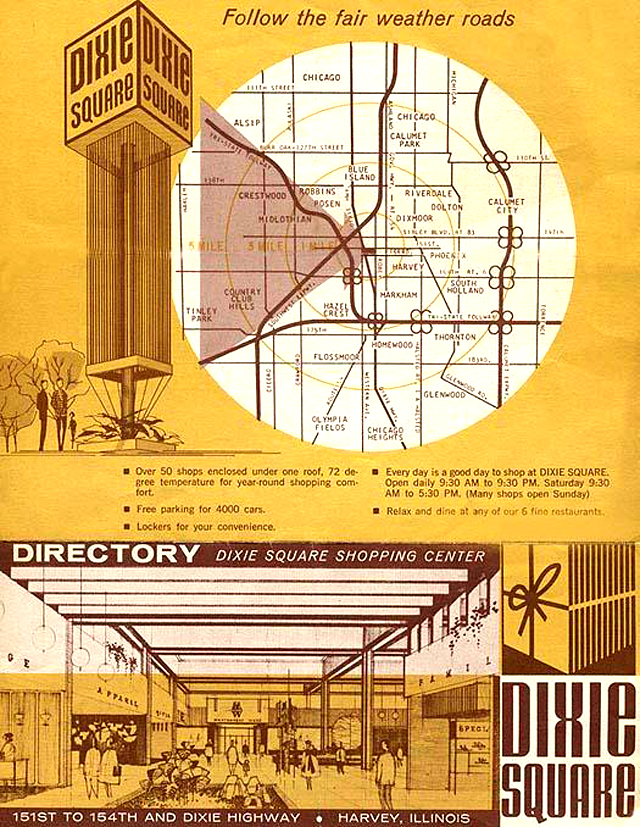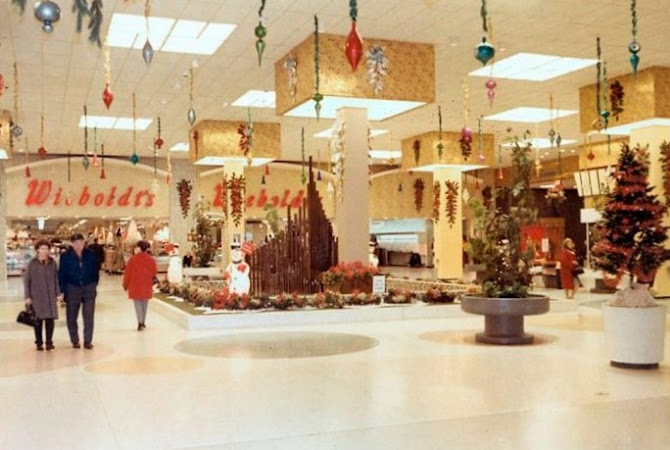Dixie Hi was a 9-hole, par 36 golf course that opened in 1923 in Harvey, Illinois. The course was designed by William H. Metz & Associates, Inc. and was named for Dixie Highway. It was maintained and operated by the city of Harvey.
Harvey incorporated 58 acres of land in 1964, including the "Dixie Hi" golf course property. The course closed in 1965 due to financial difficulties. The golf course was demolished to make way for the Dixie Square Mall.
sidebar
Dixie Hi was an excellent 9-hole course that cost $1 or $2 to play in 1950. You had to be careful looking for golf balls at the 9th hole because the open field was full of Garter snakes. Scary things, all black with yellow stripes. —Anonymous
DIXIE SQUARE MALL
Dixie Square was at 151st Street and Dixie Highway (Western Avenue), Harvey, Illinois.
Dixie Square Mall's story began in 1964 when plans were announced for a fully-enclosed shopping plaza with fifty stores and concession services. The complex was built on a 58-acre site twenty-two miles south of downtown Chicago in south suburban Harvey.
The Mall (780,000 leasable sq. ft.) was developed by Meyer C. Weiner and designed by Grand Rapids, Michigan's Hornbach & Steenwyck firm. The $25 million ($241 Million today) construction project commenced in April 1965.
The Mall opened on August 31, 1966.
Seventy-two days later, Dixie Square Mall held a premiere featuring Chicagoan Mel Tormé (1925-1999) on Thursday, November 10, 1966, the day after the Mall's Grand Opening.
Mel Tormé (1925-1999), 'The Velvet Fog,' was a famous jazz singer, musician, and actor in the 1950s and 60s. His performance at Dixie Square Mall was a major event for the new Mall. Tormé's performance was followed by a fireworks display. The event received media attention.
Mel Tormé made his professional debut at the age of 8 at the Blackhawk Restaurant in Chicago in 1933. He performed with the Coon-Sanders Orchestra, singing "You're Driving Me Crazy."
Mel Tormé "You're Driving Me Crazy" 1946
Mel Tormé performed at the following Chicago venues:
- Apollo Theater (1944).
- Chez Paree Nightclub, Tormé performed regularly (1950).
- Chez Paree Nightclub, Tormé headlines in Chicago with his own band and guests, Zoot Sims and Al Cohn. (1958).
- Chicago Jazz Festival (1956; 1995).
- Chicago Jazz Festival. Mel played drums on "Sing, Sing, Sing" with Benny Goodman (1979).
- Chicago Symphony Center with the Mel Tormé Orchestra (1984).
- Lyric Opera House of Chicago's "A Jazz Festival." Mel performed with Dizzy Gillespie and Duke Ellington. (1962)
- Lyric Opera of Chicago (1966).
- Ravinia, Highland Park, Illinois (1990 Festival).
- Steppenwolf Theatre Company in Chicago. Tormé starred in the musical "Come Back to the 5 & Dime, Jimmy Dean, Jimmy Dean." (1990)
The first business to open was Montgomery Ward in a 2-level (182,000 sq. ft.) store on October 27, 1966. JCPenney's 2-level (144,000 sq. ft.) store anchored the center of the Mall. Inline stores included Walgreens, a Jewel supermarket and F.W. Woolworth 5 & Dime. The official grand opening of the retail hub took place on November 10-12.
The early years of Dixie Square Mall were successful. The Mall drew shoppers from another south-side mall, Park Forest Plaza (1949), nine miles south of Park Forest, and River Oaks Center (1966), six miles southeast, in Calumet City.
An expansion was completed in 1970, adding a 1-level (108,400 sq. ft.) Turn֎Style Family Center.
The shopping center is being promoted as Dixie Mall.
Around the mid-70s, Dixie Mall's revenue was diminishing as more stores closed, and businesses didn't or wouldn't rent. The Mall reached the event horizon . . . the point of no escape in early 1978.
Turn Style's discount store closed at Dixie Mall in Harvey, Illinois, on January 1, 1978. It was one of the last stores to close at the Mall, which had been struggling for years. Turn֎Style closed after 12 years.
Montgomery Ward closed in December 1977, and JCPenney's in January 1978. By November, mall concourses were closed, with exterior-entranced Walgreens and Jewel stores remaining in business until early 1979.
The abandoned shopping center was signed over to the local school district, renting its space to director John Landis. He used the Mall for location shooting of his "Blues Brothers" motion picture, which was released in June of 1980.
 |
| Car-chase mall scene from the filming of the movie, "The Blues Brothers." |
Dixie Mall was utilized as a temporary school. After this, Dixie Mall was left to decay. Its roof was eventually compromised, allowing rain and snow to enter. Within a few years, the once pristine, $8 million shopping center resembled a nuclear test site.
Several botched attempts to redevelop the complex failed. During the last failed attempt, asbestos was discovered at the site, which resulted in an immediate cessation of demolition work.
In February 2010, another demolition project was announced, spearheaded by Chicago-based MG Development South Company, which gave up trying to get past the government red tape.
In retrospect, part of the decline of the shopping center has been attributed to the wave of crime that engulfed the area. Patrons were robbed and shot. Stores recorded staggering losses in the late 1970s, and the decay of the complex was becoming an issue.
Dixie Mall closed on November 19, 1978, twelve years (or 4,463 days) after opening.
A PITIFUL ENDING
Dixie Mall's twelve-year rise and fall are likely the quickest of any mid-20th century counterpart that wasn't attributed to a natural disaster. It must be a record.
sidebar
The abandoned Mall became a popular spot for urban explorers and photographers in the years after it closed. It was also featured in the 1980 movie "The Blues Brothers."The still open, Ford City Center in Chicago, took drastic measures in 2017 to curb loitering, vandalism, theft, and sexual harasment. A curfew prohibits unacompanied children 17 and younger from entering the mall after 6pm on weekdays and 7pm on weekends.
The Mall sat decrepit and decaying until the demolition of Dixie Mall started on January 25, 2012.
The project's first stage, asbestos abatement, was completed in 2 weeks. Stage two, which entailed razing select structures, was completed between February and May 2012.
Today, the site of Dixie Mall is a vacant lot. It is a reminder of a time when things were different and a cautionary tale about the dangers of complacency.
Compiled by Dr. Neil Gale, Ph.D.






















